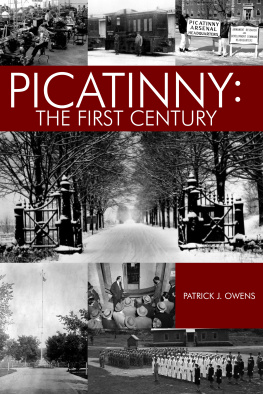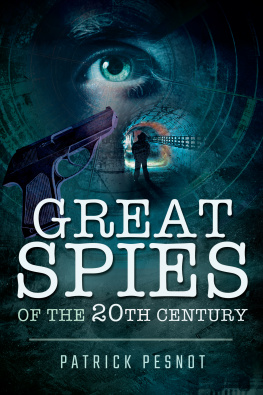Patrick J. Owens - Picatinny: The First Century
Here you can read online Patrick J. Owens - Picatinny: The First Century full text of the book (entire story) in english for free. Download pdf and epub, get meaning, cover and reviews about this ebook. year: 2018, publisher: U.S. Government Publishing Office, genre: Detective and thriller. Description of the work, (preface) as well as reviews are available. Best literature library LitArk.com created for fans of good reading and offers a wide selection of genres:
Romance novel
Science fiction
Adventure
Detective
Science
History
Home and family
Prose
Art
Politics
Computer
Non-fiction
Religion
Business
Children
Humor
Choose a favorite category and find really read worthwhile books. Enjoy immersion in the world of imagination, feel the emotions of the characters or learn something new for yourself, make an fascinating discovery.
- Book:Picatinny: The First Century
- Author:
- Publisher:U.S. Government Publishing Office
- Genre:
- Year:2018
- Rating:4 / 5
- Favourites:Add to favourites
- Your mark:
- 80
- 1
- 2
- 3
- 4
- 5
Picatinny: The First Century: summary, description and annotation
We offer to read an annotation, description, summary or preface (depends on what the author of the book "Picatinny: The First Century" wrote himself). If you haven't found the necessary information about the book — write in the comments, we will try to find it.
Picatinny: The First Century — read online for free the complete book (whole text) full work
Below is the text of the book, divided by pages. System saving the place of the last page read, allows you to conveniently read the book "Picatinny: The First Century" online for free, without having to search again every time where you left off. Put a bookmark, and you can go to the page where you finished reading at any time.
Font size:
Interval:
Bookmark:

PICATINN Y :
The First Century
Patrick J. Owens
Published by
Picatinny Arsenal Public Affairs Office, U.S. Army Armament Research, Development and Engineering Center
Mail: 93 Ramsey Ave., Picatinny Arsenal, NJ 07806-5000
Phone: 973-724-6364
This publication is a work of the U.S. Government (prepared by an employee of the U.S. Government as part of his official duties). All statements of fact, opinion or analysis are those of the author and do not reflect the official positions or views of the U.S. Government. This does not constitute an official release of U.S. Government information. Nothing in the contents shall be construed as asserting or implying U.S. Government authentication of information or endorsement of the authors views. Works of the U.S. Government are not subject to U.S. copyright laws and, therefore, can be reproduced in whole or in part. Credit must be given to U.S. Army Armament Research, Development and Engineering Center and the Picatinny Public Affairs Office, and to the author of all reproduced publications.
U.S. GOVERNMENT OFFICIAL EDITION NOTICE

USE OF ISBN
This is the Official U.S. Government edition of this publication and is herein identified to certify its authenticity. Use of the ISBN 978016078923 is for U.S. Government Publishing Office Official Editions only. The Superintendent of Documents of the U.S. Government Publishing Office requests that any reprinted edition clearly be labeled as a copy of the authentic work with a new ISBN.

For sale by the Superintendent of Documents, U.S. Government Publishing Office Internet: bookstore.gpo.gov. Phone: toll free (866) 512-1800; DC area (202) 512-1800 Fax: (202) 512-2104 Mail: Stop IDCC, Washington, DC 20402-0000
ISBN 978016078923
About the Author
Patrick J. Owens received his PhD in United States History from the University of Notre Dame in 1976 and was an Army civilian historian at Picatinny Arsenal since 1988. He has published in the E ncyclopedia of New Jersey History , The Heritage Review , and Social Science Docket .
T he perennial curse of New Jersey sites is to have their locations regularly fixed in relation to either New York or Philadelphia. For the subject of this world, the reference point is New York City, specifically the Borough of the Bronx. A person who takes the Cross-Bronx Expressway west over the George Washington Bridge and follows Interstate 80 to exit 32 can turn on to New Jersey Route 15 North and almost immediately be at Picatinny Arsenal, a 6,500-acre reservation which is the leader in researching, developing, and engineering United States Army weapons and munitions. A name occasionally heard in the documentaries which flood the History, Discovery, Military, and similarly programmed cable channels, Picatinny has played a significant role in arming Unites States troops for over a century and a quarter.
Events at an obscure support facility do not make for the most exciting reading, but these events influenced the dashing happenings which are the stuff of war movies. In its first incarnation as a powder depot, the installation sent gunpowder to troops serving in the Spanish-American War, the Philippine Insurrection, and the China Relief and Mexican expeditions. Production experiments early in the 20th century determined explosive D would fill armor-piercing rounds for over half-a-century. The powder factory established in 1907 supplied troops through two world wars while development work during the 1920s and 1930s influenced the artillery and tank rounds, fuzes, grenades, and mines of World War II and beyond. In the first years of the 1950s, Picatinny gave ground troops the 3.5-inch bazooka rocket, the C-4 explosive, and the Atomic Annie artillery shell. Soldiers in Vietnam fired Picatinny developed light antitank weapons and 40mm grenade launcher rounds. Today, if it goes boom and the Army uses it, it is probably a Picatinny product.
This book is a hodgepodge. Given its multiplicity of purposes, it could not be otherwise. On one hand, it attempts to tell readers unfamiliar with the installation what Picatinny did and how it came to do it. On the other, it offers itself as a reference work for Picatinnyans interested in the origins and development of their missions, buildings, and landscape and in the work their predecessors did and the environment in which they did it. The outsider may find discussions of where certain activities took place or when road layouts changed confusing and boring while Picatinnyans will have an easier time placing pictures with these words.
Critics are free to harp on how the chapters jump around internally, combining discussions of construction, technical developments, and social trends. This is a reflection of life at a place where people do work. Where there is work, there are buildings and technical processes. Where there are people, there is sociology. The intention is to limn interactions and show how one Army installation functioned at different periods of its career and how the people on the installation interacted with it. In short, this work tries to offer something for everyone in the firm expectation of satisfying no one.
The hodgepodge characterization applies both to the topics discussed and to the space and emphasis given to the same topics at different points in the narrative. The first chapter is heavy on details of land acquisition and construction because it was necessary to build the installation before it could do anything. Later chapters give little attention to land acquisitions because these became smaller and less complicated. Construction work varied in intensity. Chapter Three spends much space on the reconstruction following the 1926 explosion and chapter eight goes into detail on the construction of the Naval Air Rocket Test Station. Others are content to single out individual structures whose peculiarities excite interest.
After World War I, Picatinny put more emphasis on research work. Chapters three and after reflect this. The projects discussed are only a sampling of Picatinnys work and, sometimes, not the most important. For contrast, this work occasionally focuses on dead ends. It is about Picatinny as a place supporting varied efforts, a service organization for many missions. Selectivity becomes more extreme as chapters progress because the later the time frame, the more variety to Picatinny projects and the greater the number of organizations it housed. Often, the criterion for selection is not a projects technological worth or its value to national defense, but its ability to illustrate a larger point about the workings of the installation.
The start of research and development work created a bifocal arsenal, one part concentrating on production and the other on research and engineering. Chapter three is fairly comprehensive, touching on most of the efforts on-going in the early 1920s, but later chapters treat progressively smaller samples of the total Picatinny effort. Even where a project receives more than minimal space, its story may be incomplete as discussion focuses on Picatinnys role in the effort and the efforts influence on Picatinny. A running theme is the nations receipt of real value from a place ready and able to do sundry duties while learning to perform new ones quickly.
Chapter Four tells the story of the havoc wreaked at Picatinny by the explosion at the neighboring Lake Denmark Naval Ammunition Depot while Chapter Five tells of the rebuilding, stressing the role of New Deal agencies in preparing the arsenal to meet the challenges of another world war.
Font size:
Interval:
Bookmark:
Similar books «Picatinny: The First Century»
Look at similar books to Picatinny: The First Century. We have selected literature similar in name and meaning in the hope of providing readers with more options to find new, interesting, not yet read works.
Discussion, reviews of the book Picatinny: The First Century and just readers' own opinions. Leave your comments, write what you think about the work, its meaning or the main characters. Specify what exactly you liked and what you didn't like, and why you think so.












